分词作状语
- 格式:doc
- 大小:58.50 KB
- 文档页数:8

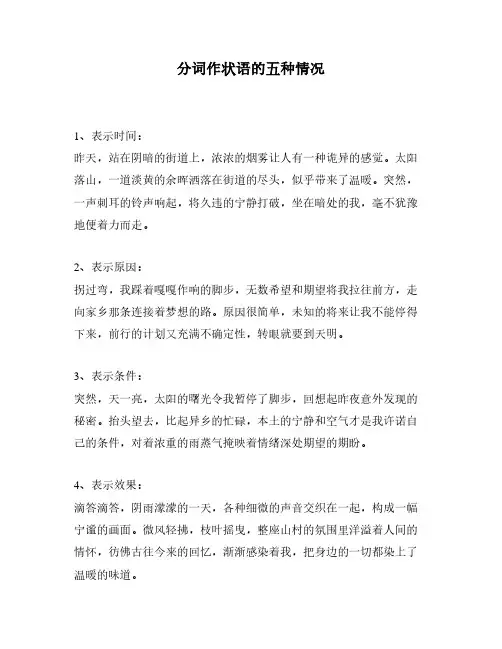
分词作状语的五种情况
1、表示时间:
昨天,站在阴暗的街道上,浓浓的烟雾让人有一种诡异的感觉。
太阳落山,一道淡黄的余晖洒落在街道的尽头,似乎带来了温暖。
突然,一声刺耳的铃声响起,将久违的宁静打破,坐在暗处的我,毫不犹豫地便着力而走。
2、表示原因:
拐过弯,我踩着嘎嘎作响的脚步,无数希望和期望将我拉往前方,走向家乡那条连接着梦想的路。
原因很简单,未知的将来让我不能停得下来,前行的计划又充满不确定性,转眼就要到天明。
3、表示条件:
突然,天一亮,太阳的曙光令我暂停了脚步,回想起昨夜意外发现的秘密。
抬头望去,比起异乡的忙碌,本土的宁静和空气才是我许诺自己的条件,对着浓重的雨蒸气掩映着情绪深处期望的期盼。
4、表示效果:
滴答滴答,阴雨濛濛的一天,各种细微的声音交织在一起,构成一幅宁谧的画面。
微风轻拂,枝叶摇曳,整座山村的氛围里洋溢着人间的情怀,彷佛古往今来的回忆,渐渐感染着我,把身边的一切都染上了温暖的味道。
5、表示方式:
趁着丝丝晨雾未散的时刻,抽出一伙人携手暗中离去,终于享受到了米饭之间的松软,延续着昔日快乐的痕迹。
把一切都收拾妥当,仿佛穿越时空一样,令一个个熟悉的瞬间再次涌现心中,萦绕着幽暗曾经的眼前。
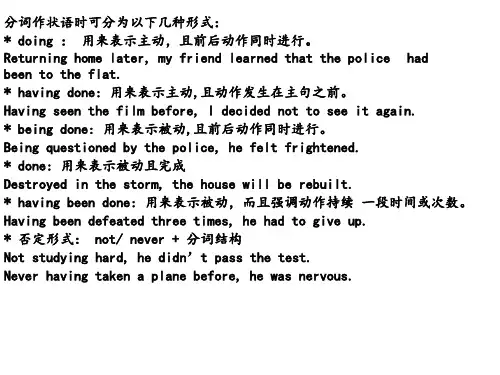

分词(现在分词、过去分词)作状语现在分词与过去分词均可作状语表示句子主语所进行的另一个动作,来对谓语表示的主要动作加以修饰或陪衬,表示时间,原因,行为方式,目的,条件或结果等,相当于其对应的状语从句。
现在分词的意义是主动的,过去分词的意义是被动的。
构成及形式1). 过去分词:动词加ed或动词的特殊变化所得的过去分词。
3). 否定式:在现在分词或过去分词前面直接加not。
现在分词表伴随:现在分词短语的作用类似一个并列分句。
Sally lied in bed crying.= and she was cryingI got home, feeling very tired.= and felt very tiredShe walked along the street, not knowing where to go.=and didn’t know……Please fill in this form, giving your name, name, address, etc.表原因:Being so poor in those days, we couldn’t afford to send the boy to hospital.= As we were so poor, we………Not knowing her address, we couldn’t get in touch with her.Many of us, being so excited, could not go to sleep that night.They sent us their statement, hoping to get our support.表时间:Seeing those pictures, he couldn’t help thinking of those old days they spent together.= when/As soon as he saw those pictures, he……Turing around, she saw an ambulance driving up.Hearing the news, they all jumped with joy.Approaching the village, I found it was empty.这几例中的现在分词短语一般放在句首表示这个动作一发生,谓语所表示的动作立即发生。
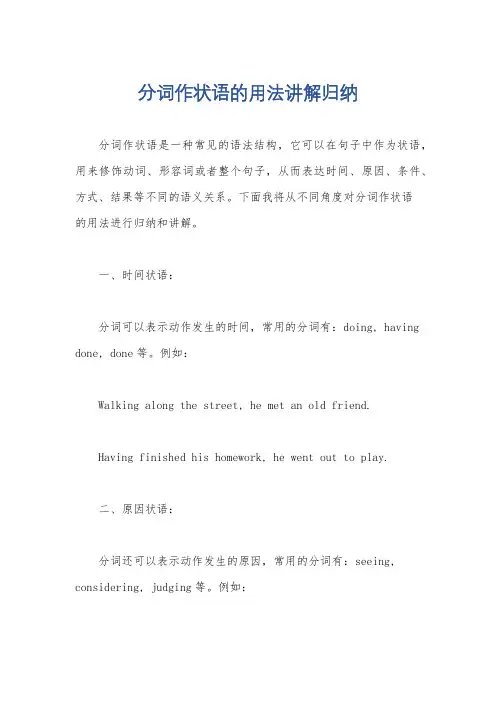
分词作状语的用法讲解归纳分词作状语是一种常见的语法结构,它可以在句子中作为状语,用来修饰动词、形容词或者整个句子,从而表达时间、原因、条件、方式、结果等不同的语义关系。
下面我将从不同角度对分词作状语的用法进行归纳和讲解。
一、时间状语:分词可以表示动作发生的时间,常用的分词有:doing, having done, done等。
例如:Walking along the street, he met an old friend.Having finished his homework, he went out to play.二、原因状语:分词还可以表示动作发生的原因,常用的分词有:seeing, considering, judging等。
例如:Seeing the heavy rain, she decided to stay at home.Considering the bad weather, we canceled the picnic.三、条件状语:分词还可以表示动作发生的条件,常用的分词有:supposing, provided, given等。
例如:Supposing the weather is fine, we will go for a picnic.Provided that you finish your work, you can go out to play.四、方式状语:分词还可以表示动作发生的方式,常用的分词有:speaking, running, working等。
例如:He ran to catch the bus, panting heavily.She answered the question, smiling brightly.五、结果状语:分词还可以表示动作的结果,常用的分词有:surprised, pleased, excited等。
例如:The news, surprising everyone, spread quickly.The children, pleased with the gifts, thanked their parents.总结起来,分词作状语的用法非常灵活多样,可以用来表示时间、原因、条件、方式和结果等不同的语义关系,丰富了句子的表达方式。
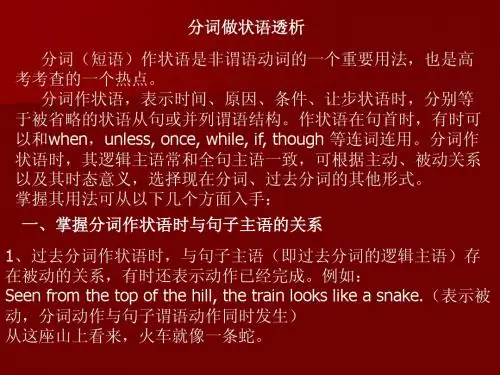
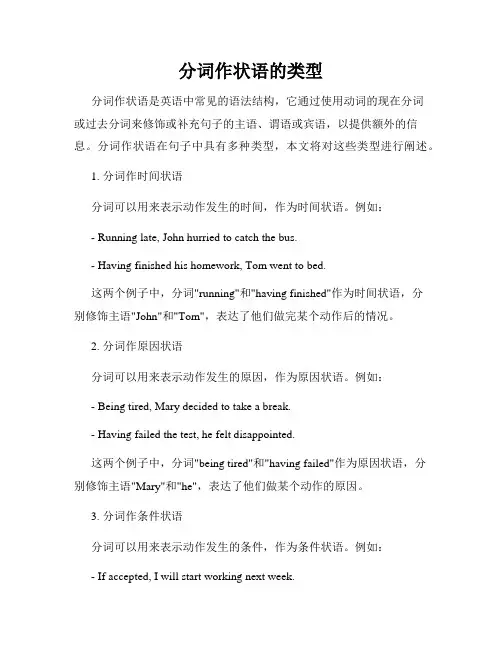
分词作状语的类型分词作状语是英语中常见的语法结构,它通过使用动词的现在分词或过去分词来修饰或补充句子的主语、谓语或宾语,以提供额外的信息。
分词作状语在句子中具有多种类型,本文将对这些类型进行阐述。
1. 分词作时间状语分词可以用来表示动作发生的时间,作为时间状语。
例如:- Running late, John hurried to catch the bus.- Having finished his homework, Tom went to bed.这两个例子中,分词"running"和"having finished"作为时间状语,分别修饰主语"John"和"Tom",表达了他们做完某个动作后的情况。
2. 分词作原因状语分词可以用来表示动作发生的原因,作为原因状语。
例如:- Being tired, Mary decided to take a break.- Having failed the test, he felt disappointed.这两个例子中,分词"being tired"和"having failed"作为原因状语,分别修饰主语"Mary"和"he",表达了他们做某个动作的原因。
3. 分词作条件状语分词可以用来表示动作发生的条件,作为条件状语。
例如:- If accepted, I will start working next week.- Without any money, he couldn't buy the ticket.这两个例子中,分词"accepted"和"without any money"作为条件状语,分别修饰主语"I"和"he",表达了他们做某个动作所需要的条件或限制。
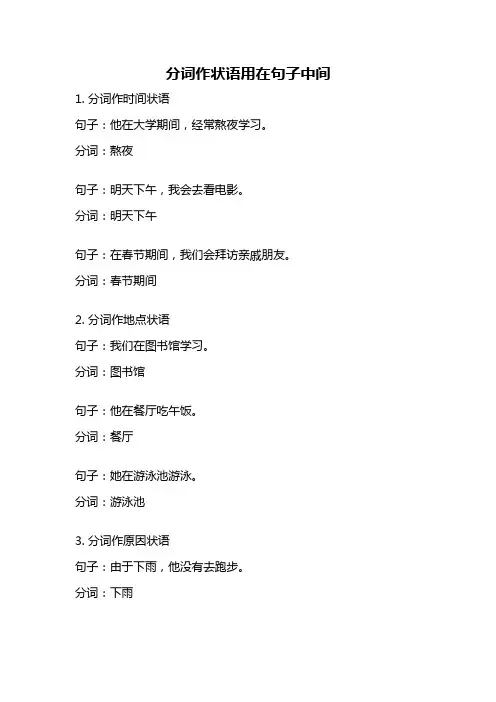
分词作状语用在句子中间1. 分词作时间状语句子:他在大学期间,经常熬夜学习。
分词:熬夜句子:明天下午,我会去看电影。
分词:明天下午句子:在春节期间,我们会拜访亲戚朋友。
分词:春节期间2. 分词作地点状语句子:我们在图书馆学习。
分词:图书馆句子:他在餐厅吃午饭。
分词:餐厅句子:她在游泳池游泳。
分词:游泳池3. 分词作原因状语句子:由于下雨,他没有去跑步。
分词:下雨句子:因为生病,她没有去上学。
分词:生病句子:考试前夜,他紧张得睡不着。
分词:紧张4. 分词作方式状语句子:他用力地跑过去。
分词:用力地句子:他小心地将花放入花瓶。
分词:小心地句子:她大声地唱歌。
分词:大声地5. 分词作条件状语句子:如果时间允许,我们会去旅行。
分词:时间允许句子:只要你努力学习,就能取得好成绩。
分词:努力学习句子:只有经过努力,才能取得成功。
分词:经过努力6. 分词作结果状语句子:他工作努力,最终获得了晋升。
分词:工作努力句子:他表现出色,因此被提名为班长。
分词:表现出色句子:他学习刻苦,考试取得了好成绩。
分词:学习刻苦7. 分词作伴随状语句子:他边吃饭边看电视。
分词:边吃饭边看电视句子:她一边走路一边打电话。
分词:一边走路一边打电话句子:他一边洗衣服一边听音乐。
分词:一边洗衣服一边听音乐8. 分词作目的状语句子:他带着相机去旅行,是为了记录美好瞬间。
分词:记录美好瞬间句子:她读书,目的是为了提高自己的知识水平。
分词:提高自己的知识水平句子:他每天锻炼身体,是为了保持健康。
分词:保持健康9. 分词作让步状语句子:尽管下雨,他还是坚持出门锻炼。
分词:下雨句子:虽然遇到困难,她仍然坚持努力。
分词:遇到困难句子:即使失败了,他也会继续尝试。
分词:失败了10. 分词作条件状语句子:只要有时间,他就会去帮助别人。
分词:有时间句子:只要你愿意,我就会一直陪伴你。
分词:愿意句子:只要努力,就一定能够成功。
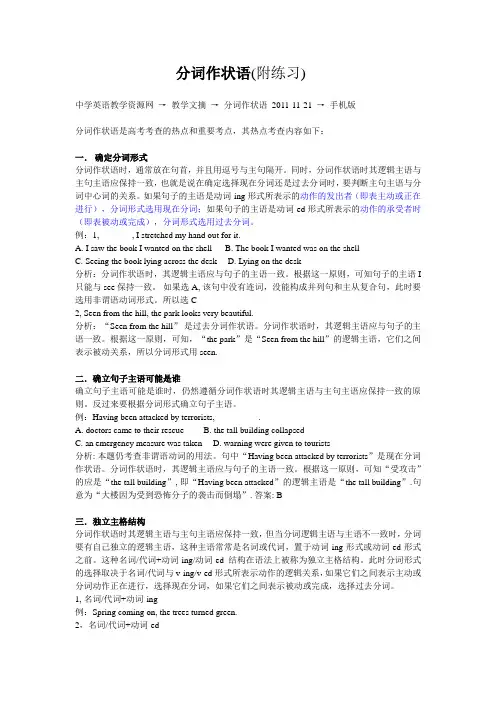
分词作状语(附练习)中学英语教学资源网→教学文摘→分词作状语2011-11-21 →手机版分词作状语是高考考查的热点和重要考点,其热点考查内容如下:一.确定分词形式分词作状语时,通常放在句首,并且用逗号与主句隔开。
同时,分词作状语时其逻辑主语与主句主语应保持一致,也就是说在确定选择现在分词还是过去分词时,要判断主句主语与分词中心词的关系。
如果句子的主语是动词-ing形式所表示的动作的发出者(即表主动或正在进行),分词形式选用现在分词;如果句子的主语是动词-ed形式所表示的动作的承受者时(即表被动或完成),分词形式选用过去分词。
例:1, _______, I stretched my hand out for it.A. I saw the book I wanted on the shellB. The book I wanted was on the shellC. Seeing the book lying across the deskD. Lying on the desk分析:分词作状语时,其逻辑主语应与句子的主语一致。
根据这一原则,可知句子的主语I 只能与see保持一致。
如果选A, 该句中没有连词,没能构成并列句和主从复合句,此时要选用非谓语动词形式。
所以选C2, Seen from the hill, the park looks very beautiful.分析:“Seen from the hill”是过去分词作状语。
分词作状语时,其逻辑主语应与句子的主语一致。
根据这一原则,可知,“the park”是“Seen from the hill”的逻辑主语,它们之间表示被动关系,所以分词形式用seen.二.确立句子主语可能是谁确立句子主语可能是谁时,仍然遵循分词作状语时其逻辑主语与主句主语应保持一致的原则。
反过来要根据分词形式确立句子主语。
例:Having been attacked by terrorists, _________.A. doctors came to their rescueB. the tall building collapsedC. an emergency measure was takenD. warning were given to tourists分析: 本题仍考查非谓语动词的用法。
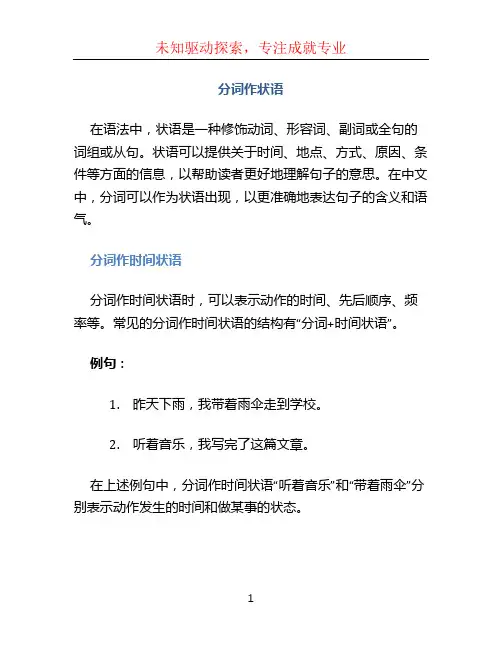
分词作状语在语法中,状语是一种修饰动词、形容词、副词或全句的词组或从句。
状语可以提供关于时间、地点、方式、原因、条件等方面的信息,以帮助读者更好地理解句子的意思。
在中文中,分词可以作为状语出现,以更准确地表达句子的含义和语气。
分词作时间状语分词作时间状语时,可以表示动作的时间、先后顺序、频率等。
常见的分词作时间状语的结构有“分词+时间状语”。
例句:1.昨天下雨,我带着雨伞走到学校。
2.听着音乐,我写完了这篇文章。
在上述例句中,分词作时间状语“听着音乐”和“带着雨伞”分别表示动作发生的时间和做某事的状态。
分词作地点状语分词作地点状语时,可以表示动作发生的地点或者动作的范围。
常见的分词作地点状语的结构有“分词+地点状语”。
例句:1.在花园里散步的时候,我发现了一只漂亮的蝴蝶。
2.躺在床上看书,我感到异常放松。
在上述例句中,分词作地点状语“在花园里散步的时候”和“躺在床上”分别表示动作发生的地点或者动作的范围。
分词作方式状语分词作方式状语时,可以表示动作的方式、方法等。
常见的分词作方式状语的结构有“分词+方式状语”。
例句:1.他用力地关上了门。
2.小明一边跳舞一边唱歌。
在上述例句中,分词作方式状语“用力地关上了门”和“一边跳舞一边唱歌”分别表示动作的方式。
分词作原因状语分词作原因状语时,可以表示动作的原因或动作发生的原因。
常见的分词作原因状语的结构有“分词+原因状语”。
例句:1.太阳下山了,天黑了。
2.因为下雨,所以他没有去散步。
在上述例句中,分词作原因状语“太阳下山了”和“因为下雨”分别表示动作发生的原因。
分词作条件状语分词作条件状语时,可以表示实现某种结果的条件。
常见的分词作条件状语的结构有“分词+条件状语”。
例句:1.如果你不努力学习,你就无法取得好成绩。
2.要是天气好,我们就去郊游。
在上述例句中,分词作条件状语“如果你不努力学习”和“要是天气好”分别表示实现某种结果的条件。
总结通过以上例句的分析,我们可以看出分词作状语能够丰富句子的表达,使得句子更加准确和生动。
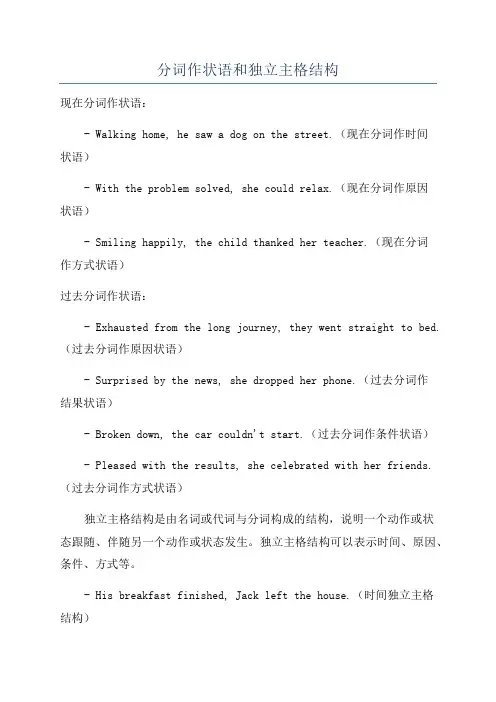
分词作状语和独立主格结构现在分词作状语:- Walking home, he saw a dog on the street.(现在分词作时间状语)- With the problem solved, she could relax.(现在分词作原因状语)- Smiling happily, the child thanked her teacher.(现在分词作方式状语)过去分词作状语:- Exhausted from the long journey, they went straight to bed.(过去分词作原因状语)- Surprised by the news, she dropped her phone.(过去分词作结果状语)- Broken down, the car couldn't start.(过去分词作条件状语)- Pleased with the results, she celebrated with her friends.(过去分词作方式状语)独立主格结构是由名词或代词与分词构成的结构,说明一个动作或状态跟随、伴随另一个动作或状态发生。
独立主格结构可以表示时间、原因、条件、方式等。
- His breakfast finished, Jack left the house.(时间独立主格结构)- The rain stopped, the players continued the game.(条件独立主格结构)- The cake eaten, the children happily played in the garden.(原因独立主格结构)- The teacher angry, the students were silent.(方式独立主格结构)需要注意的是,独立主格结构通常放在句子的开头或结尾,用逗号与主句分隔开来。
可以表示时间,原因,条件,结果,伴随,让步等情况。
举例:1.Seeing from the top of the mountain,he saw a beautiful city.2.Her mother died in 2001,leaving her with her younger brother.3.Having read the letter from her daughter,he sat down with relief.4.Not having received any letter from him, I gave him a call.对比:Not knowing his dress,she went to a policeman for help.5.Seen from the top of the mountain,Chongqing is a beautiful city.6.The child learns fast,well brought up by his parents.7.Being struck by the heavy storm,they felt helpless.8.Having been told many times,he still repeated the same mistake. 总结:分词做状语的表现形式及区别注意点:1. 表示时间关系的分词短语有时候可以由while/when引出。
Eg:When offered help,one often says,“thank you”.Be careful when crossing the street.2.有些分词货不定式短语作状语,其形式不受上下文限制,我们称其为独立成分。
常见的有:Generally/frankly speaking;Judging from/by;Considering/ taking .....into consideration;To tell you the truth;Seeing....考虑到;Supposing....假如,如果;Provided (that)....如果;3.独立主格的问题。
分词作状语与独立主格结构一、分词作状语1.动名词作状语动名词作状语常用于表示动作的方式、原因、结果等。
- 动作原因:He was late for work because of oversleeping.(他睡过头了,所以上班迟到了。
)- 动作结果:The car stopped running, causing a traffic jam.(汽车停了下来,导致了交通堵塞。
)2.现在分词作状语现在分词作状语常用于表示动作的时间、条件、原因、伴随等。
- 动作时间:Walking in the park, he met his old friend.(他在公园散步时遇到了他的老朋友。
)- 动作条件:Unless given permission, you cannot enter the building.(除非得到许可,否则你不能进入建筑物。
)- 动作原因:His face turned pale, feeling sick.(他感觉不适,脸色变得苍白。
)- 动作伴随:She burst into tears, seeing the sad news.(她看到这个悲伤的消息时,忍不住哭了起来。
)二、独立主格结构独立主格结构是指句子中的现在分词或过去分词作为非限制性状语,与主语关系疏远,独立于主句的结构。
独立主格结构一般用于表示时间、原因、条件、伴随等含义。
1.现在分词作独立主格结构现在分词作独立主格结构时,其逻辑主语通常与主句的主语不同,表示主句动作发生的时间、条件、原因、伴随等。
- 动作时间:The sun having set, we decided to go home.(太阳已经下山,我们决定回家。
)- 动作条件:The weather being fine, we went for a walk.(天气好的时候,我们去散步了。
)- 动作原因:Her husband having lost his job, she had to support the family.(她丈夫失业了,她不得不养家糊口。
分词作状语例子
1. 哎呀呀,你看“Walking in the park, he suddenly saw a beautiful flower.”(他在公园里散步时,突然看到一朵美丽的花。
)这就是分词作状语呀。
2. 嘿,“Singing loudly, she attracted everyone's attention.”(她大声唱歌,吸引了所有人的注意力。
)这不就是很好的例子嘛。
3. 哇塞,“Looking out of the window, I saw a bird flying by.”(我望向窗外时,看到一只鸟飞过。
)是不是很形象呀。
4. 哟呵,“Running in the rain, he didn't feel cold at all.”(他在雨中奔跑,一点也不觉得冷。
)这效果多棒啊。
5. 哈哈,“Waving goodbye, they left the place happily.”(他们挥挥手道别,开心地离开了那个地方。
)多有意思呀。
6. 哎呀,“Thinking about the problem, she came up with a grea t idea.”(她在思考问题时,想出了一个好主意。
)分词作状语就是这么神奇呀。
7. 嘿嘿,“Smiling sweetly, the girl made everyone feel happy.”(那个女孩甜甜地微笑,让每个人都感到开心。
)这多生动啊。
我的观点结论就是:分词作状语真的很有用呢,可以让句子更加生动形象,表达更加简洁明了,大家一定要好好掌握呀!。
非谓语动词——分词作状语精讲与精练Traveling at a speed over 400 kilometers per hour, the train can complete the 30-kilometre journey in eight minutes.英语中,分词作状语主要分以下三种情况:一.分词充当状语时,分词的逻辑主语和主句的主语一致,即为“分词作状语”二.分词充当状语时,分词的逻辑主语和主句的主语不一致,即为“独立主格”三.独立主格一般需自带主语,若省去其主语,则为独立主格中的特殊情况,即为“悬垂分词”分词作状语分词在句中作状语,修饰谓语动词或整个句子,表示动作发生的原因、时间、方式、结果、条件、伴随状况等。
分词的否定式是在一般式和完成式的前面加not (never)+分词The student sat there, not knowing what to do. (否定形式)辨析:done与being done Painted white, the room looks bright.Being painted now, the room can’t be lived i n.___________ (use) as a means of transport in China, the bike is very useful.___________ (use) by me now, the bike can’t be lent to you.2. 句法功能常可转换成相应的状语从句。
有时为了强调,分词前可带when, while, once, if, though, as if, unless等连词一起作状语,以便使句子的意思更清楚、更连贯。
1) 表时间Walking in the street, I came across an old friend of mine.=When I was walking in the street, I came across an old friend of mine.(While) waiting for the bus, he read a copy of China Daily.=While ______________________ for the bus, he read a copy of China Daily.When offered help, one often says “Thank you.” or “It’s kind of you.”=When ______________________, one often says “Thank you.” or “It’s kind of you.”某些动词,如:hear, see, arrive, leave, return, get to, look, open, close等,表示一个极短暂的动作,它们的分词可换做on+动名词,译为“一(刚)…就…”。
分词作状语的时态与语态分词可以在句子中作为状语,描述动作或状态的时间、原因、条件等。
根据上下文,分词可以使用不同的时态和语态来表达不同的意思。
本文将就分词作状语时的时态和语态问题进行探讨。
分词的时态问题当分词作状语时,它通常具有与谓语动词相对应的时态。
下面是一些常见的时态情况:1. 一般现在时态:分词在句子中表示与主句谓语同时或经常发生的动作或状态。
一般现在时态:分词在句子中表示与主句谓语同时或经常发生的动作或状态。
例如:- She sat on the bench, reading a book.(她坐在长椅上看书。
)- The students left the classroom, chatting and laughing.(学生们边聊天边笑着离开了教室。
)2. 一般过去时态:分词在句子中表示与主句谓语同时或经常发生的过去动作或状态。
一般过去时态:分词在句子中表示与主句谓语同时或经常发生的过去动作或状态。
例如:- He stood by the window, looking at the street.(他站在窗前,望着街道。
)- They ran through the field, shouting and cheering.(他们跑过田野,边喊边欢呼。
)3. 完成时态:分词在句子中表示先于主句谓语发生的动作或状态。
完成时态:分词在句子中表示先于主句谓语发生的动作或状态。
例如:- Having finished her work, she went home.(她完成了工作,回家了。
)- After having read the book, he returned it to the library.(他读完了那本书后,将其归还到图书馆。
)分词的语态问题当分词作状语时,它也可以使用不同的语态来表达不同的意思。
下面是一些常见的语态情况:1. 主动语态:分词在句子中表示动作的执行者是主语。
高考语法 分词作状语&讲解+练习分词作状语的用法可以肯定地说 分词的状语用法是所有分词用法中最重要的也是最难掌握的。
历年的高考英语考题也说明 分词作状语的用法是所有分词用法中最常考的。
因此 本文拟对分词作状语的用法作一小结和分析 同时归纳一些行之有效的做题方法和理解技巧 以帮助同学们掌握其用法。
一、用作时间状语1. 典型例句Seeing the cat, the mouse ran off. 见到猫 老鼠就跑了。
The work finished, he went home. 工作做完后 他就回家了。
2. 理解技巧分词(短语)用作时间状语通常可转换成时间状语从句(引导时间状语的从属连词需根据句意来确定) 如上面两句也可转换成When [As soon as] the mouse saw the cat, it ran off.After the work was finished, he went home.3. 高考实例When _______ different cultures, we often pay attention only to the differences without noticing the many similarities. (2006浙江卷)A. comparedB. being comparedC. comparingD. having compared【分析】此题答案选C 分词短语when comparing different cultures 相当于时间状语从句when we compare different cultures。
二、用作原因状语1. 典型例句Being very weak, she couldn't move. 她由于身体虚弱而不能行动。
His car broken down, he had to walk. 他的车坏了 所以只好走路。
Much discouraged, she moved on to London. 她很沮丧 搬到了伦敦。
2. 理解技巧分词(短语)用作原因状语通常可转换成由as, because, since, nowthat 等引导的原因状语从句 如上面三句也可转换成As she was very weak, she couldn’t move.Because his car was broken down, he had to walk.Because she was much discouraged, she moved on to London.3. 高考实例(1) ______ with so much trouble, we failed to complete the task on time. (2006四川卷)A. FacedB. FaceC. FacingD. To face【分析】答案选A。
现在分词短语faced with so much trouble可转换成原因状语从句because we were faced with so much trouble。
(2)______ for the breakdown of the school computer network, Alice wasin low spirits. (2006福建卷)A. BlamingB. BlamedC. To blameD. To be blamed【分析】答案选B。
现在分词短语blamed for the breakdown of the school computer network可转换成原因状语从句because she was blamed for the breakdown of the school computer network。
三、用作条件状语1. 典型例句Working hard, you will succeed. 如果努力工作 你就可以成功。
Adding them all up, we can find the answer. 如果把它们加起来 我们就可以得到答案。
United, we stand; divided, we fall. 团结则存 分裂则亡。
Given more time, we could have done it better. 如果多给点时间 我们可以做得更好。
2. 理解技巧分词(短语)用作条件状语通常可转换成由从属连词if引导的条件状语从句 如上面几句也可转换成If you work hard, you will succeed.If we add them all up, we can find the answer.If we are united, we stand; if we are divided, we fall.If we had been given more time, we could have done it better.3. 高考实例______ time, he’ll make a first-class tennis player. (2003北京春) A. Having given B. To give C. Giving D. Given【分析】答案选D。
give 与其逻辑主语he 是动宾关系 用过去分词 故选D。
分词短语Given time 可转换成条件状语从顺If he is given time。
四、用作让步状语1. 典型例句Living miles away, he attended the course. 虽然住在几英里以外 他仍去上课。
Defeated, he remained a popular boxer. 虽然被击败了 他仍是一个受欢迎的拳击手。
2. 理解技巧分词(短语)用作让步状语通常可转换成由从属连词though, although, no matter…等引导的让步状语从句 如上面两句也可转换成Although he lived miles away, he attended the course.Thought he was defeated, he remained a popular boxer.3. 高考实例No matter how frequently ______, the works of Beethoven still attract people all over the world. (2006广东卷)A. performedB. performingC. to be performedD. being performed【分析】答案选A。
现在分词短语performed在此相当于they areperformed。
No matter how frequently they are performed的意思是“无论它们 指贝多芬的作品 被演奏多少次”。
五、用作伴随状语1. 典型例句He sat in the chair reading a newspaper. 他坐在椅子上看报。
Don't you sit there doing nothing. 别什么也不干坐在那里。
He came in, followed by his wife. 他走了进来 后面跟着他的妻子。
2. 理解技巧理解“伴随状语”的关键是要理解“伴随”二字。
分词(短语)用作伴随状语时 它表示的动作伴随句子谓语动作同时发生即句子谓语所表示的动作为主要动作 分词短语所表示的动作伴随性的次要动作。
3. 高考实例(1) Don’t sit there ______ nothing. Come and help me with this table. (2006湖北卷)A. doB. to doC. doingD. and doing(2) My cousin came to see me from the country, ______me a full basket of fresh fruits. (2006安徽卷)A. broughtB. bringingC. to bringD. had brought(3) Whenever he was asked why he was late for class, he would answer carelessly, always _____ the same thing. (2006江苏卷)A.sayingB. saidC. to sayD. having said(4) We often provide our children with toys, footballs or basketballs,_______ that all children like these things. (2006全国卷)A. thinkingB. thinkC. to thinkD. thought【分析】以上四题答案分别为CBAA。
六、用作方式状语1. 典型例句He earns a living driving a truck. 他靠开卡车谋取生。
I'm returning you letter as requested. 我按要求给你退信。
2. 理解技巧分词(短语)用作方式状语与用作伴随状语的情形比较接近。
有时用作方式状语的现在分词可以转换成by doing sth的结构 如上面第一句也可换成He earns a living by driving a truck.注 近几年高考对分词用作方式状语的情形考得较少。
七、用作结果状语1. 典型例句He fired, killing one of the passers-by. 他开枪了 打死了一个过路人。
He died, leaving his wife with five children. 他死了 留下他妻子和五个儿子。
It rained and rained, vehicles bogged and bridges washed out. 雨不停地下 车辆陷入泥沼 桥梁被水冲去。
2. 理解技巧分词(短语)用作结果状语时 通常可转换成并列句 如上面两句也可转换成He fired and killed one of the passers-by.He died and left his wife with five children.It rained and rained, and vehicles were bogged and bridges were washedout.3. 高考实例(1) He glanced over at her, ______ that though she was tiny, she seemedvery well put together. (2005广东卷)A. notingB. notedC. to noteD. having noted【分析】答案选A 此句也可换成 He glanced over at her and notedthat though she was tiny, she seemed very well put together.(2) Oil prices have risen by 32 percent since the start of the year, _____ arecord US$ 57.65 a barrel on April 4. (2005山东卷)A. have reachedB. reachingC. to reachD. to be reaching【分析】答案选B此句也可换成Oil prices have risen by 32percent since the start of the year and reached a record US分词作状语时可分为以下几种形式* doing 用来表示主动 且前后动作同时进行。